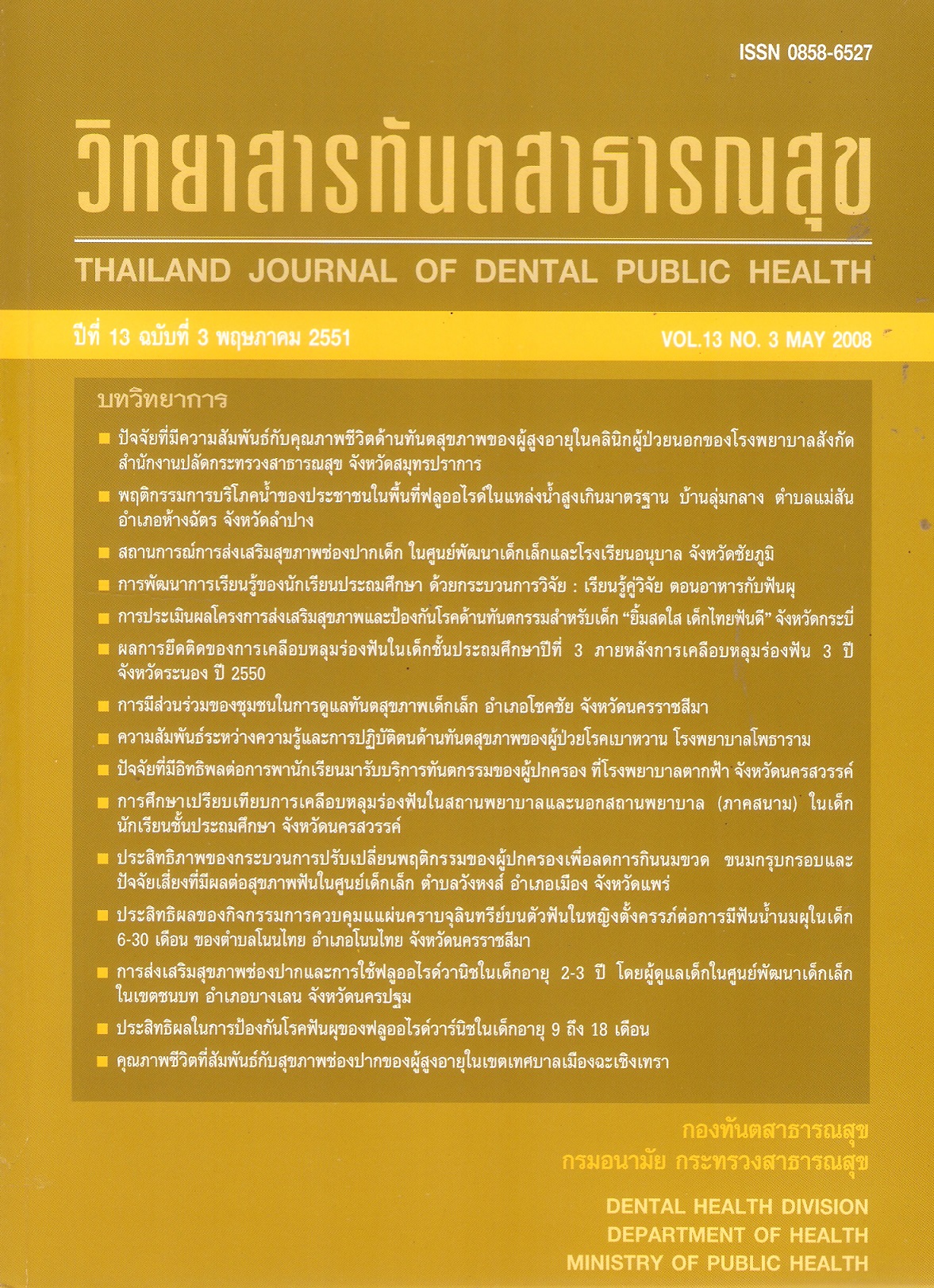Caries preventive effect of fluoride varnish in children age 9 to 18 months.
Main Article Content
Abstract
This study aimed to evaluate caries preventive effect of fluoride varnish in children between age 9 to 18 months, studied in 80 children who came to receive vaccination in well baby clinic. Samples were randomized into 2 groups, 40/group. The study group was applied fluoride varnish at mean age 9, 12 and 15 months, and the control group was applied water. Both groups had mean erupted teeth (SD) 2.2 (6.5) and 2.9 (8.3), 8.5 (14.4) and 8.3 (14.3), 17.5 (22.5) and 17.3 (22.8), 33.3 (31.8) and 32.9 (31.7) surfaces per child at mean age 9, 12, 15, 18 months respectively. Its by detecting for caries at mean age 9, 12, 15 and 18 months,found that the control group had higher caries risk than non-applied was higher caries risk than the applied. When included cavitation and non-cavitation the control group had more mean decayed surfaces than the applied 0.8, 1.9 and 3.1 surfaces per child (p = 0.00) at mean age 12, 15 and 18 months respectively and significantly higher caries incidence by surface at age between 12-to-15 and 15-to-18 months (OR = 6.0 and 2.5, 95% CI = 3.3 - 11.1 and 1.9 - 3.3, p = 0.00). When included only cavitation the control group had more mean decayed surfaces than the studied 1.9 surfaces per child (p = 0.00) at mean age 18 months and significantly higher caries incidence by surface at age between 15-to-18 months (OR = 4.0, 95% CI = 2.3 - 6.9, p = 0.00). Concluded that fluoride varnish application may be an effective intervention in preventing caries in children between age 9 to 18 months.
Downloads
Article Details
References
2. กองทันตสาธารณสุข กรมอนามัย กระทรวงสาธารณสุข, รายงานผลการสํารวจสภาวะ ทันตสุขภาพแห่งชาติ ครั้งที่ 5 พ.ศ.25432544. กรุงเทพมหานคร: โรงพิมพ์ บริษัทสามเจริญพาณิชย์ จํากัด. 2545.
3. โรงพยาบาลตระการพืชผล, รายงานการสํารวจสภาวะทันตสุขภาพ กลุ่มอายุ 0-3 ปี อําเภอตระการพืชผล จังหวัดอุบลราชธานี [เอกสารอัดสําเนา]. อุบลราชธานี: โรงพยาบาลตระการพืชผล: 2542.
4. เศวต ทัศนบรรจง.การสูญเสียฟันน้ํานมในเด็ก ว. ทันต 2530;37(4-6):186-194.
5. Ripa LW. Nursing caries: a comprehensive review. Pediatr Dent 1988:10(4):268-82.
6. Ismail AI. Prevention of early childhood caries. Community Dent Oral Epidemiol 1998;26(1):49-61,
7. Kidd EAM, Joyston-Bechal S. Essentials of dental caries: the disease and its management. In: London: Henry Ling Ltd., 1987. p. 88-89.
8. Bawden JW. Fluoride varnish: a useful new tool for public health dentistry. J Public Health Dent 1998;58(4):266-9.
9. Koch G, Petersson LG, Gleerup A, Lowstedt E. Kinetics of fluorine in deciduous enamel after application of fluoride-containing vamish (Duraphat). Swed Dent J 1982:6(1):39-44.
10. Yanover L. Fluoride varnishes as cariostatic agents: a review. J Can Dent Assoc 1982;48(6):401-4.
11. Holm AK. Effect of fluoride varnish (Duraphat) in preschool children Community Dent Oral Epidemiol 1979;7(5):241-5.
12. Weinstein P, Domoto P, Koday M, Leroux B. Results of a promising open trial to prevent baby bottle tooth decay: a fluoride varnish study. ASDC J Dent Child 1994;61(5-6):338-41.
13. assiu i evang70, nun iyun. อายุการขึ้นของฟันน้ํานมเด็กไทยในเขต กรุงเทพมหานครที่มีการเจริญเติบโตเป็นปกติ 1. Yun 2534;41(5):207-13.
14. Banting DW. International fluoride supplement recommendations. Community Dent Oral Epidemiol 1999;27(1):57-61.
15. O-Sullivan DM, Tinanoff N. Social and biological factors contributing to caries of the maxillary anterior teeth. Pediatr Dent 1993;15(1):41-4.
16. Seow WK. Amaratunge A. Sim R, Wan A. Prevalence of caries in urban Australian aborigines aged 1-3.5 years. Pediatr Dent 1999;21(2):91-6.
17. องค์การอนามัยโลก. การสํารวจสภาวะทันตสุขภาพแบบมาตรฐานขององค์การอนามัยโลก ฉบับพิมพ์ครั้งที่ 4 ค.ศ. 1997: แปลโดย ศูนย์ ทันตสาธารณสุขระหว่างประเทศ.พิมพ์ครั้งที่ 1 เชียงใหม่: บ. กลางเวียงการพิมพ์, 2541.
18. Autio-Gold J, Courts F. Assessing the effect of fluoride varnish on early enamel carious lesions in the primary dentition. J Am Dent Assoc 2001;132(No 9):12471253.
19. Weintraub J, Ramos-Gomez F, Jue B, Shain S, Hoover C, Featherstone J, et al. Fluoride varnish efficacy in preventing early childhood caries. J Dent Res 2006:Feb 85(2):172-6.
20. Mattos-Graner R, Rontani RM, Gaviao MB, Bocatto HA. Caries prevalence in 6-36-month-old Brazilian children. Community Dent Health 1996:13(2):96-8.
21.0-Sullivan DM, Tinanoff N. Maxillary anterior caries associated with increased caries risk in other primary teeth. J Dent Res 1993;72(12):1577-80.
22. Alaluusua S, Malmivirta R. Early plaque accumulation a sign for caries risk in young children. Community Dent Oral Epidemiol 1994;22(5 Pt 1):273-6.
23. Thylstrup A, Fejerskov 0, editors. Text book of Cariology. In.: Munksgaard; 1986. p. 214
24. Seppa L. Effect of dental plaque on fluoride uptake by enamel from a sodium fluoride varnish in vivo. Caries Res 1983;17(1):71-5.
25. ชุติมา ไตรรัตน์วรกุล, รพีพรรณ โชคสมบัติชัยพฤติกรรมการเลี้ยงนมและของเหลวอื่นด้วย ขวดนมและปัจจัยที่สัมพันธ์กับอัตราผุถอนอุด ในเด็กก่อนวัยเรียนกลุ่มหนึ่ง, ว. ทันต 2541; 48(5):259-268.
26. บุบผา ไตรโรจน์, ศรีสุดา ลีละศิธร, สุรางค์ เชษฐพฤนท์, สุภาวดี พรหมมา, การศึกษา สถานการณ์การเลี้ยงดูเด็กของผู้ปกครองที่มี ผลต่อสภาวะโรคฟันผุในเด็กปฐมวัย พ.ศ. 2547. ว. ทันต. สธ. 2548 ; 10(1-2):29-39.


